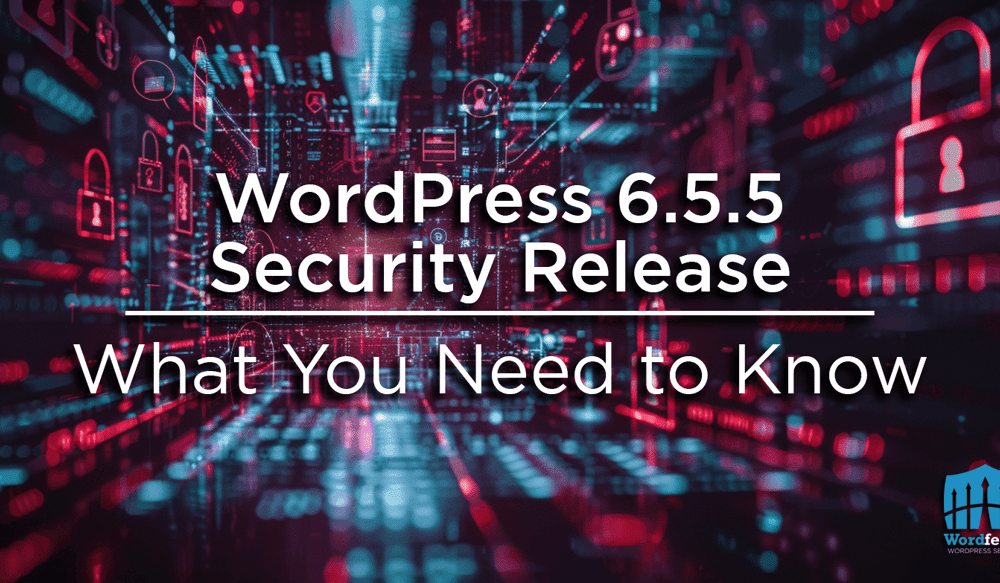Introduction
WordPress is the backbone of millions of websites around the globe, powering everything from personal blogs to large-scale enterprise sites. Given its widespread use, ensuring the security of WordPress installations is crucial. With the release of WordPress 6.5.5, users are provided with essential security updates that address various vulnerabilities and enhance the overall security of their websites.
What’s New in WordPress 6.5.5?
The latest security release, WordPress 6.5.5, introduces several key features designed to fortify your site against potential threats. This update primarily focuses on patching security flaws that could be exploited by malicious actors. Let’s dive into the specifics of what this new version offers:
Key Features
- Improved User Authentication: Enhanced protocols to ensure only legitimate users can access your site.
- Advanced Malware Detection: New algorithms to detect and mitigate malware before it can cause harm.
- Strengthened Encryption: Better encryption methods to protect your data from unauthorized access.
Security Enhancements
WordPress 6.5.5 addresses several vulnerabilities, including cross-site scripting (XSS) flaws, SQL injection risks, and unauthorized file uploads. These enhancements ensure your site remains secure and robust against various attack vectors.
Understanding the Vulnerabilities Addressed
Security updates are crucial because they address specific vulnerabilities that, if left unpatched, could compromise your website.
Types of Vulnerabilities
- Cross-Site Scripting (XSS): Allows attackers to inject malicious scripts into webpages viewed by others.
- SQL Injection: A method where attackers can execute arbitrary SQL code on a database.
- Unauthorized File Uploads: Exploits that allow hackers to upload harmful files to your server.
Potential Impacts
If these vulnerabilities are not addressed, they could lead to data breaches, loss of user trust, and significant financial repercussions. Updating to WordPress 6.5.5 mitigates these risks, providing peace of mind to site owners.
Why You Should Update Immediately
Updating to WordPress 6.5.5 is not just about accessing new features; it’s about protecting your site from potential threats.
Protection Against Exploits
Hackers are constantly on the lookout for vulnerabilities in popular platforms like WordPress. By updating to the latest version, you shield your site from known exploits.
Improved Performance
Security updates often come with performance improvements, ensuring your site runs smoothly and efficiently.
How to Update to WordPress 6.5.5
Updating WordPress is a straightforward process, but it’s important to follow best practices to ensure a smooth transition.
Step-by-Step Guide
- Backup Your Site: Always start by creating a backup of your site.
- Navigate to Dashboard: Go to your WordPress dashboard.
- Select Updates: Click on “Updates” in the sidebar.
- Click Update Now: Follow the prompts to update to the latest version.
Best Practices for Safe Updating
- Check Plugin and Theme Compatibility: Ensure all your plugins and themes are compatible with the new version.
- Test in Staging Environment: If possible, test the update in a staging environment before applying it to your live site.
Backup Before Updating
Backing up your site is a critical step before performing any updates.
Importance of Backups
Backups ensure that you have a restore point in case something goes wrong during the update process.
How to Create a Backup
- Use a Plugin: Utilize backup plugins like UpdraftPlus or BackupBuddy.
- Manual Backup: Alternatively, you can manually back up your files and database through your hosting control panel.
Testing After Updating
After updating, it’s important to test your site to ensure everything is functioning correctly.
Ensuring Compatibility
Check all functionalities of your site, including forms, payment gateways, and interactive elements, to ensure they work as expected.
Common Issues and Fixes
- Broken Plugins: Update or replace plugins that cause issues.
- Theme Conflicts: Switch to a default theme to identify and resolve theme-related problems.
Plugins and Themes Compatibility
Ensuring that your plugins and themes are compatible with WordPress 6.5.5 is vital for maintaining site functionality.
Checking Compatibility
Before updating, check the plugin and theme developer’s notes for compatibility information with WordPress 6.5.5.
Updating Plugins and Themes
Regularly update your plugins and themes to their latest versions to prevent compatibility issues and security vulnerabilities.
Enhancing Security Post-Update
Updating WordPress is just one part of maintaining a secure website. Additional security measures can further protect your site.
Additional Security Measures
- Use Strong Passwords: Encourage the use of strong, unique passwords for all users.
- Enable Two-Factor Authentication: Add an extra layer of security to your login process.
Recommended Security Plugins
- Wordfence Security: Provides comprehensive security features, including a firewall and malware scanning.
- Sucuri Security: Offers security auditing, malware detection, and other protective measures.
Common Mistakes to Avoid
Avoiding common pitfalls can help ensure a smooth update process.
Avoiding Downtime
- Schedule Updates During Low Traffic Times: Minimize the impact on your users by scheduling updates during off-peak hours.
- Communicate with Users: Inform your users of the planned update to manage their expectations.
Ensuring Smooth Update Process
- Follow Best Practices: Adhere to the recommended steps for updating WordPress.
- Seek Professional Help: If unsure, consider hiring a professional to handle the update process.
Real-World Examples of Security Breaches
Understanding past security breaches can highlight the importance of regular updates and security measures.
Case Studies
- Example 1: A major e-commerce site was compromised due to outdated WordPress, leading to significant financial loss.
- Example 2: A popular blog experienced a data breach that exposed user information, resulting in a loss of user trust.
Lessons Learned
- Regular Updates Are Crucial: Ensure your WordPress installation is always up-to-date.
- Comprehensive Security Measures: Implement additional security measures beyond just updating WordPress.
Future of WordPress Security
WordPress continues to evolve, with the community actively working on improving security features.
Upcoming Features
- Improved User Permissions: Enhanced control over user roles and permissions.
- Automated Security Updates: Future updates may include more automated security features.
Community Contributions
The WordPress community plays a significant role in identifying vulnerabilities and contributing to security improvements. Engaging with the community can help you stay informed about the latest security trends.
Getting Help and Support
If you encounter issues or have questions, various resources are available to assist you.
WordPress Support Resources
- Official WordPress Support: The official support site provides extensive documentation and forums.
- Hosting Provider Support: Many hosting providers offer dedicated WordPress support.
Community Forums
- WordPress.org Forums: Engage with other WordPress users and experts to find solutions to your problems.
- Social Media Groups: Join WordPress-related groups on platforms like Facebook and Reddit for community support.
Conclusion
Keeping your WordPress site updated, especially with security releases like 6.5.5, is essential for maintaining the integrity and security of your website. Regular updates, combined with robust security practices, ensure that your site remains safe from potential threats.
FAQs
1. Why are regular updates important? Regular updates are crucial because they address security vulnerabilities, improve performance, and ensure compatibility with new features and plugins.
2. How often does WordPress release security updates? WordPress releases security updates as needed, typically whenever a new vulnerability is discovered and patched.
3. Can I revert to an older version if I encounter issues? Yes, but it’s generally not recommended due to security risks. Always troubleshoot and resolve issues with the latest version if possible.
4. What should I do if my site is hacked? Immediately restore your site from a backup, update all software, and strengthen your security measures. Consider consulting a security professional.
5. How can I contribute to WordPress security? You can contribute by reporting vulnerabilities, participating in the WordPress community, and supporting ongoing development efforts.



